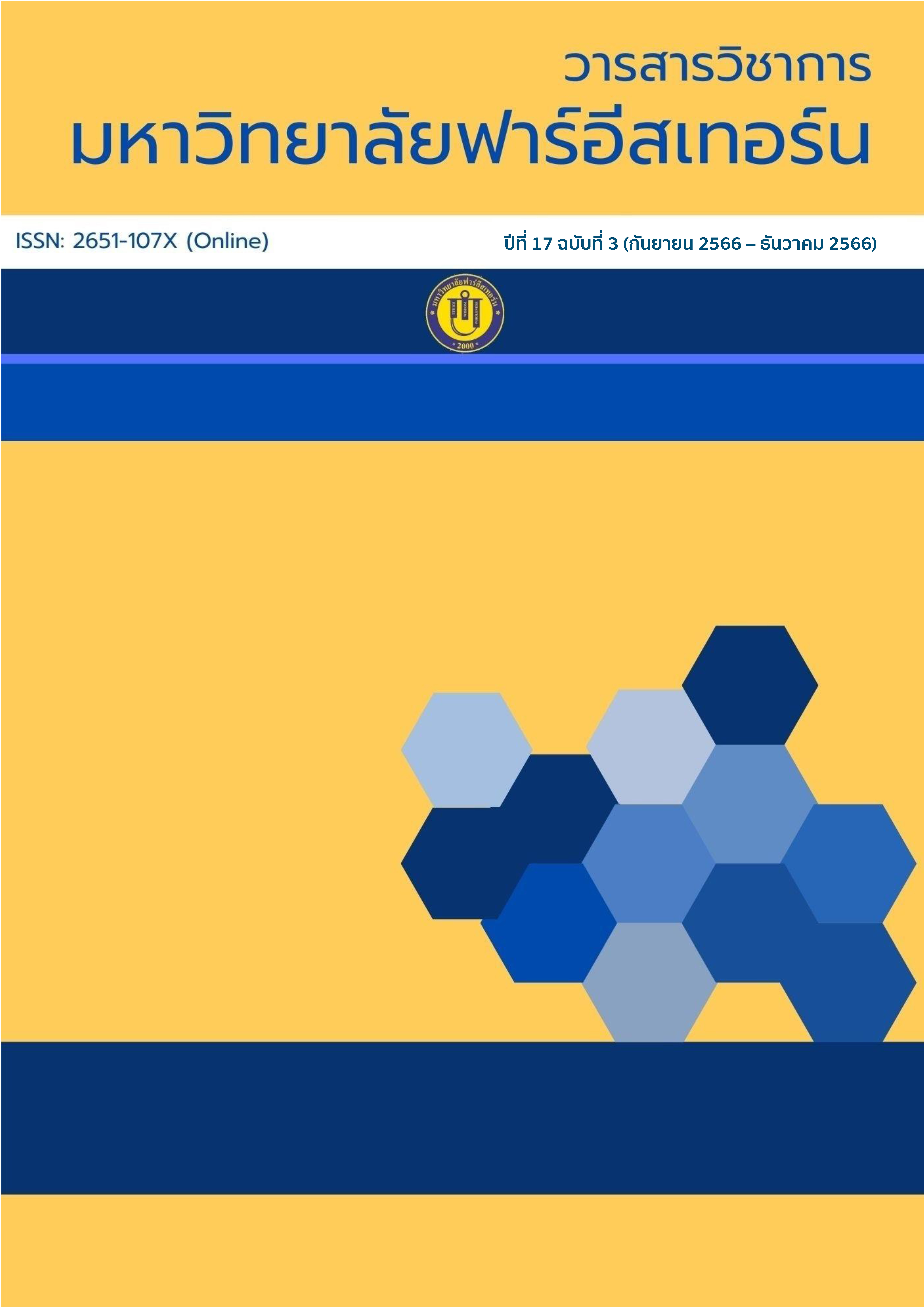The Developing of Listening and Speaking Abilities by Digital Media for Young Children
Main Article Content
Abstract
This research aimed to design and developing the experience plan for listening and speaking abilities experiences using digital media for young children. And to compare listening and speaking abilities after using digital media. The samples of this research were 29 young children studying in kindergarten, Semester 2, academic year 2022, Ban Santikeeree School, Chiang Rai Primary Educational Service Area Office 3. The samples of this research were selected by using Cluster Random Sampling. The tool used is the experience plan and assessment of listening and speaking abilities. It was analyzed to find the efficiency of the tools using the formula E1/E2 and compared using the mean (), standard deviation (S.D.) and t-test. The results of the research revealed 1) The experience plan for listening and speaking abilities experiences using digital media for young children, efficiency E1/E2 was 86.72/90.11. It can promote fine listening and speaking abilities for young children 2) the compare of the experience plan for listening and speaking abilities experiences using digital media for young children. the score was high, statistically significant at the .01
Article Details

This work is licensed under a Creative Commons Attribution-NonCommercial-NoDerivatives 4.0 International License.
1. Any views and comments in the Journal of Social Innovation and Lifelong Learning are the authors’ views. The editorial staff have not to agree with those views and it is not considered as the editorial’s responsibility.
2. The responsibility of content and draft check of each article belongs to each author. In case, there is any lawsuit about copyright infringement. It is considered as the authors’ sole responsibility.
3. The article copyright belonging to the authors and The Far Eastern University are copyrighted legally. Republication must be received direct permission from the authors and The Far Eastern University in written form.
References
กิ่งกาญจน์ สุพรศิริสิน, สมสิรี มนัส, รัตนา เจงพิบูลพงศ์, และ ภัทรพร จันทมุณี. (2563). ประสิทธิภาพของสื่อดิจิทัลเพื่อการเล่าเรื่องผ่านภาพที่มีต่อแรงจูงใจของผู้เรียน. วารสารวิชาการบัณฑิตวิทยาลัยสวนดุสิต, 16(1), 81-93.
กุลยา ตันติผลาชีวะ. (2551). การจัดกิจกรรมการเรียนรู้สำหรับเด็กปฐมวัย. กรุงเทพฯ: สำนักพิมพ์สาราเด็ก.
จันทิมา เคลือบสำราญ, จุฑาทิพย์ แสนวัฒน์, ก้องเกียรติ ไกรยสวน, และ อภิวัฒน์ กิ่งแสง. (2564). การพัฒนาทักษะการฟังและพูดภาษาอังกฤษ ผ่านสื่อมัลติมีเดีย ระดับปฐมวัย. วารสารวิชาการมหวิทยาลัยการจัดการและเทคโนโลยีอีสเทิร์น, 18(1), 119-124.
ชวนพิศ จะรา. (2556). การพัฒนาการเรียนด้วยเทคโนโลยีผสานความจริง (AR) ร่วมกับหนังสือนิทานสองภาษาโดยใช้กระบวนการกลุ่มเพื่อส่งเสริมความสามารถทางภาษาด้านการฟังและการพูดของเด็กปฐมวัย [วิทยานิพนธ์ปริญญามหาบัณฑิต, มหาวิทยาลัยเทคโนโลยีพระจอมเกล้าธนบุรี].
ณัฐณิชา มณีพฤกษ์. (2565). การพัฒนาชุดกิจกรรมศิลปะที่บูรณาการเทคโนโลยีดิจิทัลเพื่อเสริมสร้างแรงจูงใจในการสร้างสรรค์งานศิลปะสำหรับเด็กปฐมวัย [วิทยานิพนธ์ปริญญาครุศาสตร์มหาบัณฑิต, จุฬาลงกรณ์มหาวิทยาลัย].
ดรุณวรรณ แก้วหนูนวล. (2557). การพัฒนาสื่อประสมเพื่อฝึกการพูดสำหรับเด็กออทิสติกโรงเรียนสาธิตแห่งมหาวิทยาลัยเกษตรศาสตร์ ศูนย์วิจัยและพัฒนาการศึกษา [วิทยานิพนธ์ปริญญามหาบัณฑิต, มหาวิทยาลัยเกษตรศาสตร์].
ธีระยุทธ์ หมันหลี, ณัฐพล รำไพ, และ กอบกุล สรรพกิจจำนง. (2561). การพัฒนาบทเรียนออนไลน์ เรื่อง การประเมินพัฒนาการเด็กตามคู่มือเฝ้าระวังและส่งเสริมพัฒนาการเด็กปฐมวัยสำหรับนิสิตแพทย์. https://edtech.edu.ku.ac.th/ผลงานนิสิต/2564/บทความวิจัย_การพัฒนาบทเรียนออนไลน์%20เรื่อง.
นัดทพร สีสถาน และ ศรีกัญภัสสร์ รังษีบวรกุล. (2557). ผลการพัฒนาทักษะการฟังและการพูด ภาษาไทยของนักเรียนชั้นอนุบาลปีที่ 2 โดยใช้กิจกรรมการเล่านิทาน. วารสารสังคมศาสตร์วิชาการ, 7(3), 7-17.
ปรัชกร พรหมมา และ ไพฑูรย์ ศรีฟ้า. (2560). การพัฒนาแอปพลิเคชันเกมสามมิติประเภทสวม บทบาทเพื่อพัฒนาทักษะการ เรียนรู้คำศัพท์ภาษาอังกฤษสำหรับนักเรียนชั้นประถมศึกษาปีที่ 2 ที่มีความรู้ด้านภาษาอังกฤษในระดับต่ำ. วารสารวิชาการครุศาสตร์อุตสาหกรรมพระจอมเกล้าพระนครเหนือ, 8(2), 221-229.
ปุณณรัตน์ พิงคานนท์. (2565). รูปแบบการใช้สื่อดิจิทัลกับการเรียนรู้ทางสังคม และการเสริมสร้างความสัมพันธ์ระหว่างบุคคลของเด็กปฐมวัย. วารสารนิเทศศาสตร์ธุรกิจบัณฑิตย์, 1(2), 156-169.
พริมม์รฎา ปาระมี. (2565). การใช้การสอนภาษาแบบมุ่งปฏิบัติงานร่วมกับการใช้สื่อดิจิทัลเพื่อพัฒนาความสามารถในการฟัง-พูดภาษาอังกฤษและความเชื่อมั่นในตนเองของนักเรียนชั้นประถมศึกษาปีที่ 6 [วิทยานิพนธ์ปริญญามหาบัณฑิต, มหาวิทยาลัยเชียงใหม่].
พิศณุ ชัยจิตวณิชกุล. (2561). การออกแบบและพัฒนาสื่อเพื่อการศึกษาโดยใช้โปรแกรม Construct 2. อุดรธานี: มหาวิทยาลัยราชภัฏอุดรธานี.
ภัทรสุดา ยะบุญวัน. (2564). การพัฒนากิจกรรมการเรียนรู้เรื่อง การประยุกต์ใช้เทคโนโลยีดิจิทัลสำหรับการเรียนการสอนด้วยสื่ออินโฟกราฟิกที่ส่งผลต่อการรู้ดิจิทัล. [วิทยานิพนธ์ปริญญามหาบัณฑิต, มหาวิทยาลัยศิลปากร].
รอฮันนี เจะเลาะ. (2561). การพัฒนาทักษะการฟังและการพูดของเด็กปฐมวัย โดยการจัดกิจกรรม เสริมประสบการณ์ที่ใช้นิทานประกอบภาพ. วารสารมหาวิทยาลัยราชภัฏยะลา, 13(1), 41-46.
โรงเรียนบ้านสันติคีรี. (2563). รายงานประกันคุณภาพภายในสถานศึกษาโรงเรียนบ้านสันติคีรี. โรงเรียนบ้านสันติคีรี.
สรวงมณฑ์ สิทธิสมาน. (2560). การบริหารจัดการสื่อดิจิทัลเพื่อเด็กปฐมวัย [วิทยานิพนธปริญญามหาบัณฑิต, มหาวิทยาลัยศิลปากร].
สุทธิลักษณ์ กันธิพันธ์. (2566). การพัฒนาสื่อวีดิทัศน์คำศัพท์ภาษาอังกฤษของนักเรียนชั้นประถมศึกษาปีที่ 3/1 โรงเรียนบ้านสันโค้ง (เชียงรายจรูญราษฎร์). วารสารการวิจัยการศึกษาขั้นพื้นฐาน, 3(1), 172-187.
Chomsky, N. (1957). Syntactic Structure. The Hague: Mouton. Cowie, A. P.
Dewey, J. (1963). Experience and Education. New York: Macmillan.
Manajuti, P. (2007). Thailand language for children. M.p.t.: Publisher gleaming friends.
McNeil, D. (1970). Handbook of Educational Supervision: A Guide for the Practitioner. Boston: Allyn and Bacon Inc.
Moerk, E. L. (1992). A study of the Ability of Principals to Identify the Development Level of Teachers as a Prerequisite for Implementing Developmental Supervision. Dissertation Abstract International. 10(1)[27], 33–58.
Pinker, S. (1994). Theory and Practice of Supervision. New York: Dodd & Mead Company.
Skinner, B. F. (1957). Verbal hehavior. New York: Appleton-Century-Crofts.

